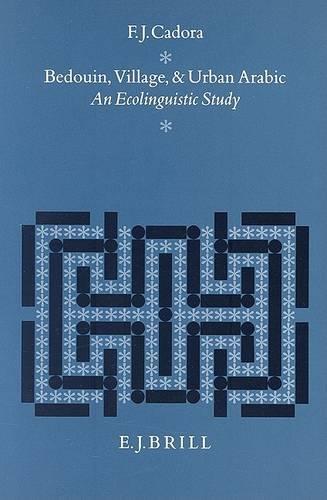Overview
As a culture area, the Arab world has had different ecological structures - nomadic (bedouin) and sedentary (rural and urban) - with parallel linguistic systems. Throughout the long history of the Arabic language, the development of transitional stages has generated linguistic correlates in Arabic dialects. The notion ""ecolinguistics"", combined and reinforced with the concepts of ""compatibility"" and ""lexical diffusion"", is introduced in this study to identify such a sociolinguistic change. The domain of change for this ecolinguistic variation is the extended family wherein the middle generation develops new lexical items by the application of ecolinguistic rules. Cadora describes these rules, which speakers generate as they gradually acquire an awareness of the social parameters for their use. The theoretical framework and the putative results of this study are offered to stimulate further research in the causation and implementation of linguistic change, especially in terms of quantitative analyses of ecolinguistic variation and lexical diffusion in the Arabic language.
Full Product Details
Author: F. J. Cadora
Publisher: Brill
Imprint: Brill
Volume: 18
Dimensions:
Width: 15.50cm
, Height: 2.30cm
, Length: 23.50cm
Weight: 0.473kg
ISBN: 9789004096271
ISBN 10: 9004096272
Pages: 168
Publication Date: 01 May 1992
Audience:
College/higher education
,
Professional and scholarly
,
Postgraduate, Research & Scholarly
,
Professional & Vocational
Format: Hardback
Publisher's Status: Active
Availability: Out of stock

The supplier is temporarily out of stock of this item. It will be ordered for you on backorder and shipped when it becomes available.
Reviews
' The sociolinguistic change of one dialect to another is a thrilling subject. In his book, Cadora gives us some useful concepts for studying this process.'<br>M. Kossmann, Bibliotheca Orientalis, 1993.<br>' This book has widened the horizons of Arabic dialectology. It is to be hoped that future studies based on more extensive sociolinguistic data will be built upon this foundation.'<br>Kristen Brustad, MESA Bulletin, 1994.<br>' This book is very well written and is very elegantly presented.'<br>Yasir Suleiman, Journal of Semitic Studies, 1995.<br>
'The sociolinguistic change of one dialect to another is a thrilling subject. In his book, Cadora gives us some useful concepts for studying this process.' M. Kossmann, Bibliotheca Orientalis, 1993. 'This book has widened the horizons of Arabic dialectology. It is to be hoped that future studies based on more extensive sociolinguistic data will be built upon this foundation.' Kristen Brustad, MESA Bulletin, 1994. 'This book is very well written and is very elegantly presented.' Yasir Suleiman, Journal of Semitic Studies, 1995.
' The sociolinguistic change of one dialect to another is a thrilling subject. In his book, Cadora gives us some useful concepts for studying this process. ' M. Kossmann, Bibliotheca Orientalis , 1993. ' This book has widened the horizons of Arabic dialectology. It is to be hoped that future studies based on more extensive sociolinguistic data will be built upon this foundation. ' Kristen Brustad, MESA Bulletin , 1994. ' This book is very well written and is very elegantly presented. ' Yasir Suleiman, Journal of Semitic Studies , 1995.
Author Information
Frederic J. Cadora is Professor of Arabic Studies since 1983 at the Ohio State University, and Chairman of the Department of Judaic and Near Eastern Languages and Literatures since 1982. He has published numerous books, textbooks, articles and reviews on Arabic linguistics.




